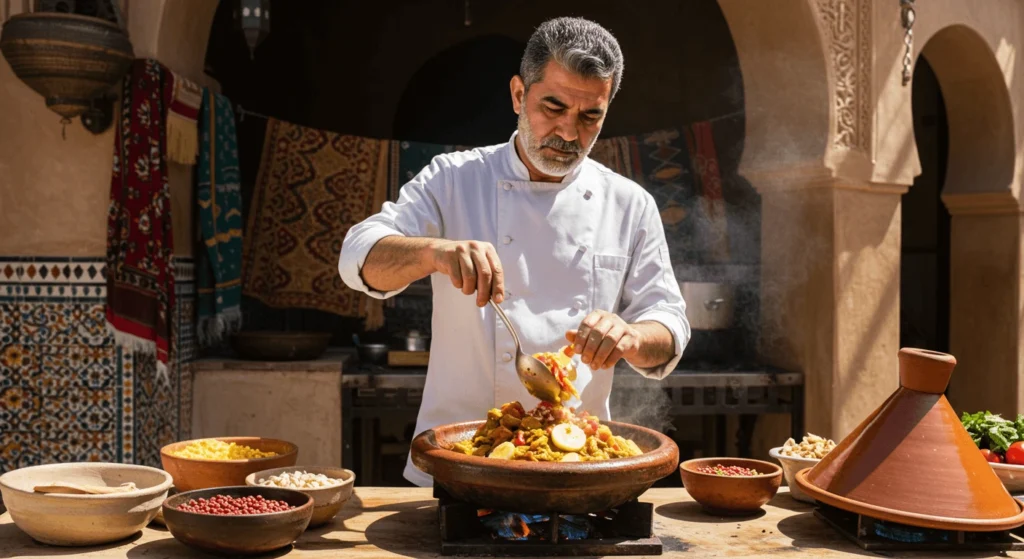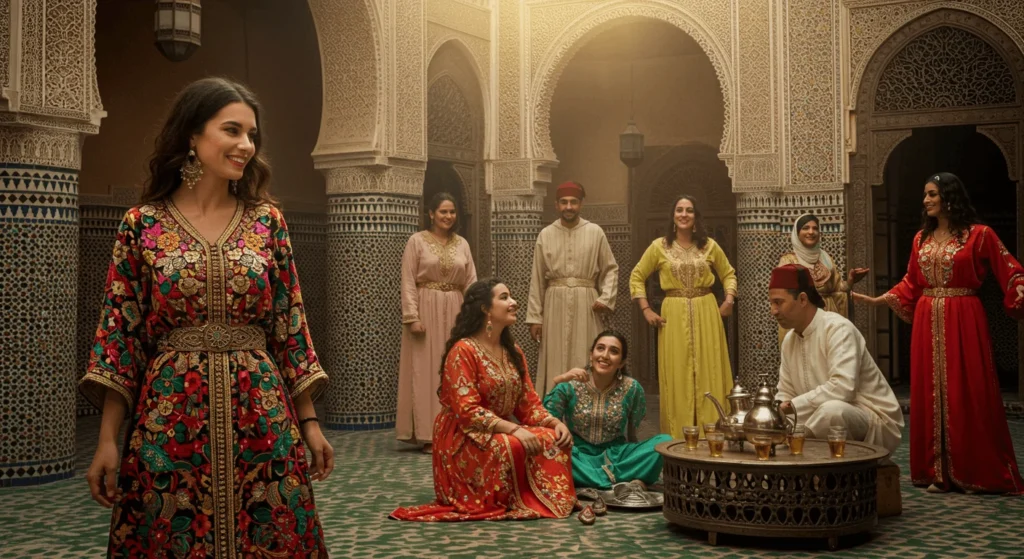Introduction
Morocco is renowned for its rich culinary heritage, where every meal reflects tradition and flavor. The bustling souks, filled with aromatic spices, and the sizzling tagines showcase the essence of a true Moroccan Cuisine Experience. It’s an adventure that captivates all the senses, from sight and smell to taste and touch.
A Moroccan Cuisine Experience is more than just a meal—it’s a sensory journey. Vibrant colors, tantalizing aromas, and bold flavors create a feast as visually stunning as it is delicious. Imagine dipping freshly baked khobz into a steaming lamb tagine with preserved lemons. The sweet and savory balance in every dish highlights Morocco’s diverse cultural influences, from Berber traditions to Arab and Andalusian inspirations.
In this post, we’ll uncover the highlights of a Moroccan Cuisine Experience, explore the magic of its spices, and dive into its rich dining culture. Whether you’re a seasoned foodie or simply curious about Moroccan flavors, this journey will introduce you to the best of a Moroccan Cuisine Experience. Let’s embark on a delicious adventure through Morocco’s culinary landscape!
A Symphony of Spices: The Foundation of the Moroccan Cuisine Experience
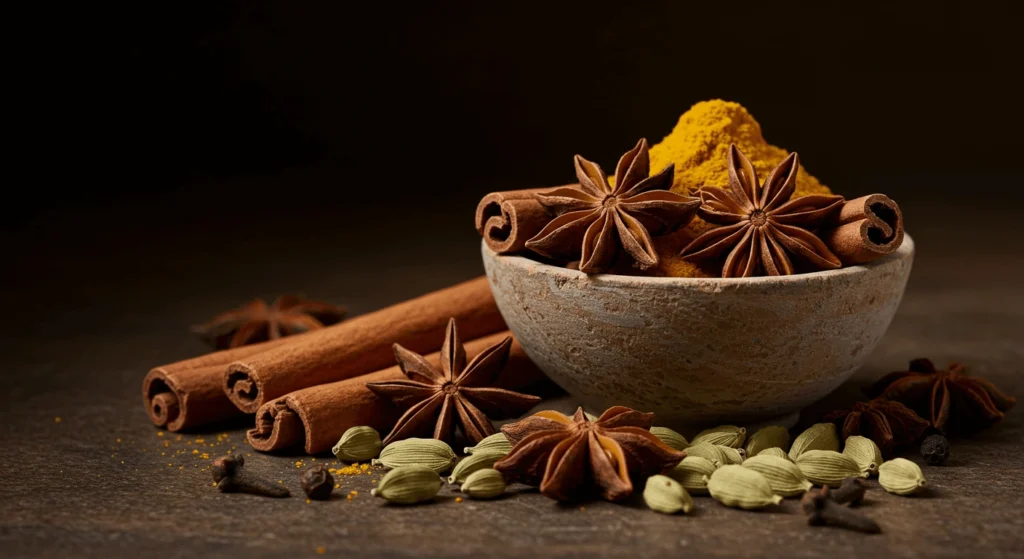
Moroccan cuisine is famous for its vibrant spices, which transform simple dishes into unforgettable sensory experiences. These spices not only define the country’s culinary identity but also weave a story of Morocco’s rich history and diverse influences. Let’s explore the essential elements that make Moroccan cuisine a true feast for the senses.
Spice Blends That Define the Moroccan Cuisine Experience:
Ras el Hanout: The Essential Spice Blend
Ras el Hanout, meaning “head of the shop,” is a signature Moroccan spice blend with up to 30 ingredients. This blend often includes cumin, coriander, turmeric, cinnamon, cardamom, and nutmeg. It varies from one vendor to another, ensuring each version is unique. Ras el Hanout is integral to iconic dishes like lamb tagines, couscous, and roasted chicken. For instance, lamb tagine with apricots and almonds derives its warm, rich flavor from this spice blend. Moreover, Ras el Hanout enhances rice dishes and marinades, offering layers of complexity with each bite.
Saffron and Preserved Lemons: Elevating Aromas and Flavors
Saffron, often referred to as “red gold,” is one of Morocco’s most prized culinary treasures. Harvested in the Taliouine region, this luxurious spice adds depth, fragrance, and vibrant color to Moroccan dishes. Chicken tagine with saffron and olives, for example, embodies the spice’s subtle yet distinctive aroma. Complementing saffron, preserved lemons are another essential ingredient. Their tangy, briny flavor balances the sweetness of saffron, creating a harmonious depth in dishes like chicken with preserved lemons and green olives. Together, these ingredients elevate Moroccan cuisine, making it an unforgettable experience.
Cinnamon and the Sweet-Savory Balance
Cinnamon holds a unique place in Moroccan cooking, bridging the gap between sweet and savory flavors. Used in both main courses and desserts, it surprises the palate with its versatility. Pastilla, for example, is a savory meat pie topped with a layer of powdered sugar and cinnamon, blending the rich flavors of spiced meat with subtle sweetness. Additionally, cinnamon features prominently in seffa, a dessert made with steamed couscous, sugar, and almonds. These unexpected combinations demonstrate Morocco’s mastery of balancing contrasting flavors to create unforgettable dishes.
Essential Herbs and Aromatics in a Moroccan Cuisine Experience:
Moroccan cuisine relies heavily on fresh herbs and aromatics to enhance its dishes. Parsley and cilantro are staples in Moroccan kitchens, often used as garnishes or mixed directly into dishes. They brighten flavors in salads like zaalouk, a smoky eggplant dip, and are also stirred into hearty stews. Garlic, another essential aromatic, is typically crushed with olive oil to form the base of marinades for meats or seafood. Combined, these herbs and aromatics provide Moroccan cuisine with its signature freshness and vibrancy.
Iconic Dishes for the Ultimate Moroccan Cuisine Experience

Moroccan food is full of rich flavors, vibrant spices, and a mix of cultures. These must-try dishes bring the best of Morocco to your plate.
Tagine Varieties in a Moroccan Cuisine Experience:
Moroccans often prepare tagine, named after the clay pot it’s cooked in, to create deeply flavorful meals. For example, lamb tagine with prunes and almonds offers a perfect mix of sweet and savory flavors. Similarly, chicken tagine with preserved lemons and green olives creates a tangy and fresh taste. People often pair it with khobz, a traditional Moroccan bread. Vegetarian options, such as tagines with spiced carrots, zucchini, and potatoes, are also common. Furthermore, the slow cooking process blends the spices—cumin, paprika, and ginger—into every bite, making the dish unforgettable.
Couscous as a Staple in the Moroccan Cuisine Experience:
Couscous, a staple in Morocco, is often served on Fridays as part of family gatherings. People layer fluffy semolina grains with vegetables like carrots, zucchini, and turnips. Additionally, many cooks add chicken or lamb to make it heartier. Sweet toppings, such as caramelized onions, raisins, and almonds, balance the savory flavors. To make it even more authentic, they drizzle smen, a preserved butter, over the dish before serving. As a result, couscous becomes a delicious and filling meal for all.
Harira: A Comforting Soup in the Moroccan Cuisine Experience:
Harira is a soup that many enjoy throughout the year, though it is especially popular during Ramadan. For instance, families often serve it to break the fast, alongside dates and chebakia, a sesame pastry. This soup combines lentils, chickpeas, and tomatoes with spices like cinnamon and turmeric. Furthermore, cooks thicken it with flour or egg, giving it a creamy texture. To finish, fresh coriander adds a burst of flavor, making every spoonful satisfying and comforting.
Street Food Gems to Enrich Your Experience:
Moroccan streets are full of unique and exciting flavors. For example, vendors sell snail soup, or babbouche, a fragrant broth made with aniseed and herbs. Along the coasts, sardine sandwiches are popular, often seasoned with chermoula—a mix of garlic, parsley, and paprika. In addition, msemen, a flaky pancake, is a favorite for breakfast or snacks. Many people eat it with honey or stuff it with savory fillings like spiced meat. Lastly, no street food experience is complete without a glass of sweet mint tea, which enhances the flavors of the meal.
Desserts and Beverages to Elevate Your Moroccan Cuisine Experience
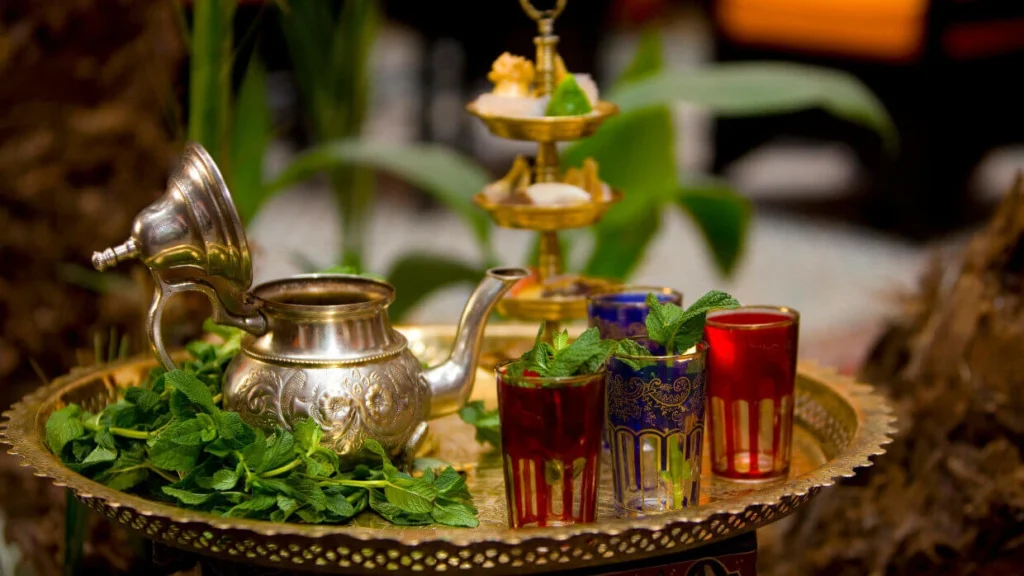
Moroccan desserts and beverages are an integral part of the country’s culinary heritage, offering sweet flavors and unique traditions. Whether you’re savoring pastries or sipping refreshing drinks, these delights enhance any Moroccan dining experience.
Sweet Treats That Define the Moroccan Cuisine:
Moroccan desserts reflect a love for nuts, honey, and fragrant spices. For example, almond briouats are crispy pastries stuffed with almond paste, lightly flavored with orange blossom water, and drizzled with honey. These bite-sized delights often appear at celebrations and special gatherings. Similarly, chebakia, a sesame-coated treat shaped into intricate patterns, is fried until golden and dipped in honey. It is particularly popular during Ramadan, often served alongside harira. Another must-try is m’hanncha, a coiled pastry filled with almond paste and flavored with cinnamon and orange blossom water. Its name, meaning “snake,” reflects its unique spiral shape, making it as visually stunning as it is delicious.
The Ritual of Mint Tea:
Mint tea, often called “Moroccan whiskey,” holds deep cultural significance. It is not just a drink but a symbol of hospitality and friendship. For instance, when guests arrive, hosts typically prepare tea as a welcoming gesture. The preparation involves brewing green tea with fresh mint leaves and sugar, then pouring it from a height to create a frothy top. This method not only aerates the tea but also enhances its aroma. Served in small, decorated glasses, mint tea pairs beautifully with desserts like msemen or chebakia. Furthermore, the ritual of sharing tea often includes lively conversations, adding warmth to the experience.
Unique Beverages to Explore in a Moroccan Cuisine:
In addition to mint tea, Morocco boasts an array of refreshing drinks. One popular choice is sharbat, a creamy almond milk often enhanced with a touch of orange blossom water. This drink is both nourishing and cooling, making it perfect for warm days. Similarly, freshly squeezed orange juice is widely available in Moroccan markets. Vendors use locally grown oranges, known for their intense sweetness and flavor. These juices provide a natural energy boost and are often served during breakfast or as an afternoon refreshment. Additionally, some stalls offer variations like mixed fruit juices, which blend seasonal fruits for a vibrant and refreshing treat.
Dining Traditions and Community in the Moroccan Cuisine Experience
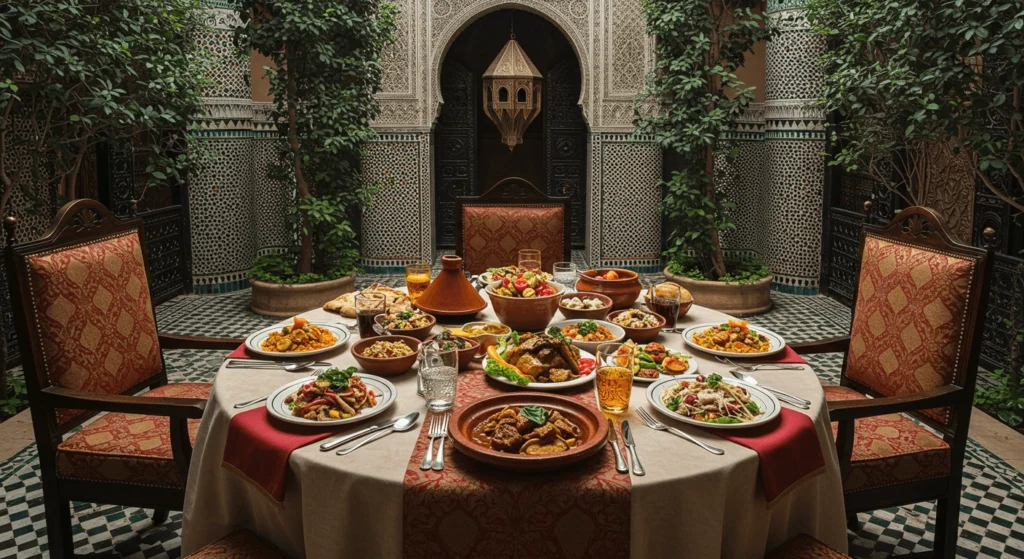
In Morocco, food is more than sustenance—it is a way to connect, celebrate, and express cultural identity. Dining traditions reflect the warmth and hospitality of Moroccan society, creating experiences that unite families and communities.
Shared Meals in the Moroccan Cuisine Experience:
Sharing meals is central to Moroccan dining culture. Families and friends often gather around a single large plate, typically a tagine or couscous. For instance, diners use pieces of khobz, the traditional Moroccan bread, to scoop up food instead of utensils. This communal style of eating fosters a sense of togetherness and encourages lively conversations. Additionally, Moroccans typically use only their right hand while eating, as this aligns with cultural customs. Whether celebrating a special occasion or enjoying a casual dinner, the act of sharing food deepens social bonds and reflects Morocco’s emphasis on community.
Bread as a Staple in the Moroccan Cuisine Experience:
Bread, or khobz, is an essential part of every Moroccan meal. Baked daily, it comes in various forms, such as the round and crusty khobz dyal zraa, made with semolina, and the softer batbout, which resembles pita bread. Moroccans often bake bread at home, but communal ovens, or ferrans, are common in neighborhoods, where families bring dough to be baked. Bread serves not only as a food but also as a utensil, used to scoop up stews, tagines, or dips like zaalouk. In addition, bread carries symbolic significance in Moroccan culture, representing sustenance and gratitude.
Festive Foods That Celebrate the Moroccan Cuisine Experience:
Special occasions in Morocco are marked by unique dishes that reflect the importance of the event. During Ramadan, families break their fast with harira, accompanied by dates and honey-soaked chebakia. On Eid al-Fitr, celebratory meals include rich lamb dishes and an array of sweet pastries. Weddings feature elaborate spreads, including pastilla, a savory-sweet pie made with chicken or pigeon, almonds, and cinnamon. Large gatherings often conclude with a méchoui, where guests share roasted lamb seasoned with traditional spices. These festive dishes symbolize abundance and hospitality, bringing people together to celebrate life’s milestones.
Souks and Markets: A Key to the Moroccan Cuisine Experience:
Morocco’s vibrant souks and markets are more than places to shop—they are hubs of daily life and community interaction. For example, shoppers haggle with vendors over fresh produce, spices, and meats, creating lively exchanges filled with humor and camaraderie. Additionally, many families visit the souk weekly to buy ingredients for traditional meals, strengthening their connection to local farmers and artisans. Seasonal produce, such as olives, oranges, and figs, often shapes the dishes prepared at home. Beyond groceries, food stalls serve quick snacks like sardine sandwiches or msemen, allowing shoppers to refuel while enjoying the bustling atmosphere.
Moroccan dining traditions are deeply tied to its culture and values. From communal meals to bustling souks, every aspect of food reflects a strong sense of community, hospitality, and shared experiences.
Sensory Delights of the Moroccan Cuisine Experience
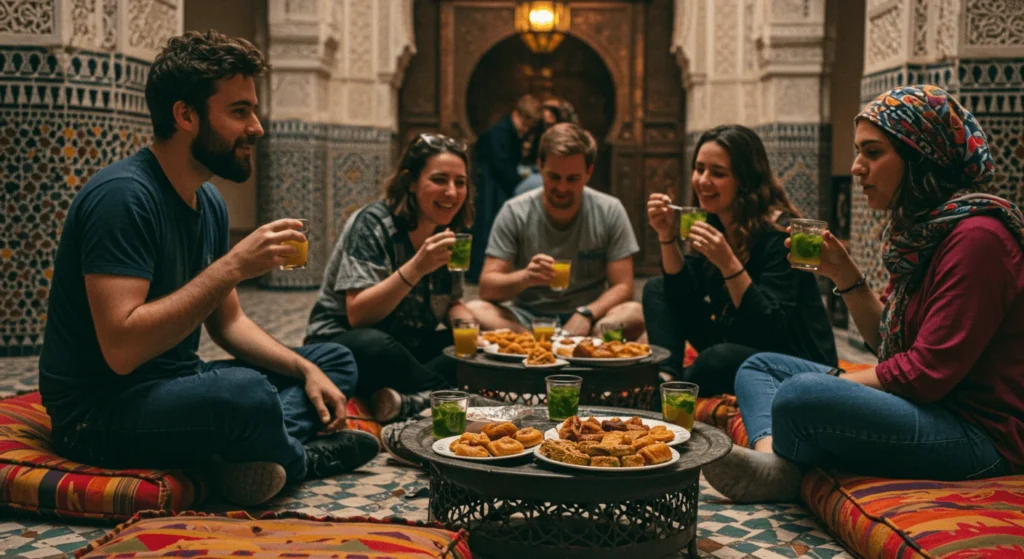
Moroccan cuisine is a feast for the senses, offering an unforgettable experience of vibrant colors, textures, and aromas. Each dish tells a story, captivating diners with its beauty and rich sensory appeal.
The Visual Appeal of a Moroccan Cuisine Experience:
Moroccan dishes are a visual masterpiece, thanks to their bold use of colors. For instance, saffron gives dishes like couscous tfaya a rich golden hue, while paprika and turmeric create deep red and yellow tones in tagines. Fresh herbs, such as parsley and cilantro, add pops of green, enhancing the dish’s freshness. Similarly, dishes like zaalouk, a smoky eggplant salad, showcase a medley of earthy tones. Even the presentation is artful, with food often arranged on intricately patterned plates that reflect Morocco’s traditional craftsmanship. These vibrant visuals make every meal as pleasing to the eyes as it is to the palate.
Textural Contrasts That Enrich the Moroccan Cuisine Experience:
Moroccan cuisine excels in creating textural contrasts that delight every bite. For example, crisp briouats, stuffed with spiced meat or sweet almonds, complement the tender, slow-cooked meats in a tagine. Similarly, the creamy texture of harira contrasts beautifully with the crunch of sesame-coated chebakia. Another notable example is msemen, a flaky pancake with layers that pull apart easily, offering a satisfying chew. These contrasts not only add complexity but also ensure that each dish keeps diners engaged from start to finish.
The Aromatic Charm of Moroccan Food:
The aromas of Moroccan cuisine are as captivating as its flavors. The scent of freshly baked khobz wafts through neighborhood ferrans (communal ovens), tempting passersby. Likewise, simmering tagines release the warm, earthy fragrances of spices like cinnamon, cumin, and coriander, which mingle harmoniously. During Ramadan, the sweet and spicy aroma of chebakia being fried fills the air, evoking memories of family gatherings. Even a simple cup of mint tea has an aromatic charm, as the fresh mint leaves release their invigorating scent when brewed. Together, these aromas create an atmosphere of warmth and anticipation.
Traditional Ambiance at the Moroccan Table:
The dining experience in Morocco extends beyond the food to include the ambiance and setting. Traditional Moroccan tables are adorned with vibrant, patterned dishes and silver teapots etched with intricate designs. For example, a typical table might feature taginesserved on colorful ceramics, paired with glasses of mint tea in gilded cups. Additionally, families often eat while seated on plush cushions around a low table, fostering intimacy and comfort. Lanterns and candles cast warm, golden light, enhancing the cozy atmosphere. This combination of décor and setting transforms every meal into a cultural celebration.
Moroccan cuisine captures the essence of sensory delight through its aesthetics, textures, aromas, and ambiance. Every detail, from the vibrant spices to the intricate table settings, contributes to an immersive dining experience that stays with you long after the meal.
Why Moroccan Cuisine Is a Feast Worth Exploring
Moroccan cuisine is more than just food—it’s an art form, a cultural expression, and a feast for all the senses. The vibrant colors, enticing aromas, and rich flavors of its dishes come together to create an unforgettable experience that captures the heart and soul of Morocco.
Exploring the World Through Moroccan Flavors:
For those eager to explore Moroccan cuisine, there are countless ways to start. You can visit local Moroccan restaurants to sample authentic dishes like harira, chebakia, or a classic lamb tagine. Many establishments recreate the traditional ambiance, complete with Moroccan décor, music, and mint tea served in elegant teapots.
If you enjoy cooking, experimenting with Moroccan recipes at home is another rewarding option. For example, you can prepare zaalouk, a smoky eggplant dip, or try baking khobz, the beloved Moroccan bread. Spices like cumin, paprika, and cinnamon are widely available and can bring a taste of Morocco to your own kitchen.
Bringing Moroccan Traditions to Your Table:
However, nothing compares to experiencing Moroccan cuisine in its homeland. Visiting Morocco allows you to fully immerse yourself in its culinary heritage. Wander through the bustling souks, where vendors display vibrant spices, fresh produce, and aromatic teas.
Participate in a cooking class in Marrakesh or in Fez to learn from skilled chefs who share traditional techniques. Enjoy a meal under the stars in the Sahara Desert, savoring a freshly prepared tagine while the aroma of mint tea fills the air. These moments create memories that last a lifetime.
Immersing Yourself in Morocco’s Culinary Heritage:
Even if traveling isn’t possible right now, exploring Moroccan cuisine locally or at home is a fantastic way to connect with this rich cultural tradition. Each dish you try brings you closer to Morocco’s warm hospitality and passion for food.
So, whether you’re planning a future trip, dining out, or cooking at home, let Moroccan cuisine transport you to a world of flavors and traditions worth savoring.
